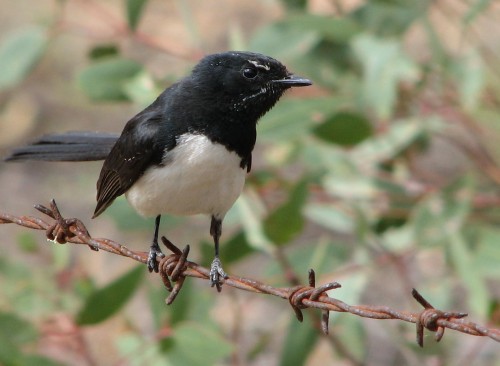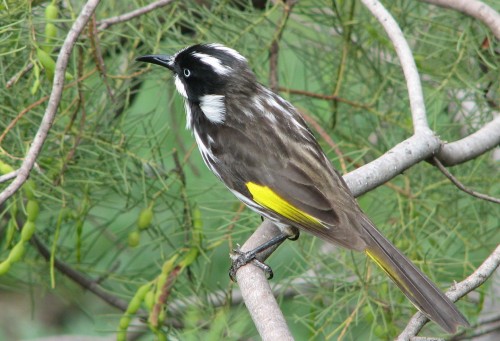Honeyeaters of Lowan Conservation Park
Lowan Conservation Park is a reserve of remnant mallee scrub in the midst of wheat and sheep farms. It is several hundred hectares in size with a rainfall of probably about 300mm in an average year. It is about 120km east of Adelaide in South Australia.
When the mallee trees are in flower the honeyeaters abound. I have visited when there have been no trees flowering and consequently very few honeyeaters. On other occasions I haven’t know where to point my binoculars first, there are so many birds. On these exciting occasions the birding is simply wonderful. I have observed the following species in or near the park:
- Red Wattlebird – resident and common
- Singing Honeyeater – resident and common
- White Eared Honeyeater – resident and common
- Spiny Cheeked Honeyeater – probably resident
- Brown Headed Honeyeater – resident and common
- Yellow Plumed Honeyeater – probably resident
- Striped Honeyeater – regular visitor spring, summer
- White Fronted Honeyeater – possibly resident
Other species which could occur when the conditions are right include:
- Purple Gaped Honeyeater
- Yellow Throated Miner
- White Plumed Honeyeater
- New Holland Honeyeater
- Black Honeyeater
- Tawny Crowned Honeyeater
New Holland Honeyeater nest
Birds can be very sneaky at times.
We were having breakfast in our sunroom this morning. As we ate, my wife observed a New Holland Honeyeater flying to what appeared to be a nest in a nearby bush in our garden (a Meleleuca lanceolata). A closer inspection of the bush revealed a dainty nest with two eggs.
Right under our noses they had built this nest and laid the eggs without us noticing.
Amazing.
This gives us a good opportunity to observe the progress of the nest and the young as they hatch. The trick will be to keep away and not inspect the nest too often. I do not to disturb them, seeing it is so close to the house.
Aggressive Bird Behaviour in the Garden
While working in the garden yesterday morning I was suddenly alerted to a noisy confrontation nearby. Our resident Willie Wagtails love to frequent one particular spot where there is an abundance of insects.
Suddenly a New Holland Honeyeater dived in to reap his share of the smorgasbord. The Willie Wagtail became quite aggressive, fanning his tail up high, ruffling the feathers all over and calling in what seemed to me to be in quite an angry – perhaps even distressed – way.
The honeyeater retreated to a nearby tree, only to swoop in repeatedly over the next few minutes. Each time the honeyeater would snap at the Willie Wagtail, zip away a metre or so, grab another insect, and retreat hurriedly to the refuge tree.
These attacks seemed to trigger even more aggression in the Willie Wagtail who decided to front up to the interloper. They then faced each other at about ten paces (bird step size – about 10cm) angrily calling in each others’ face. One last beakful of food and the New Holland Honeyeater decided that other parts of the garden were more attractive anyway, and it flew off. The Willie Wagtail continued to feast contentedly on his little patch.
Further reading:
- Aggressive birds – articles from my archives
This post updated in September 2015.
Gluepot Bird Sanctuary – more photographs
I’ve just been editing some of the photographs I took on my recent visit to Gluepot Bird Sanctuary near Waikerie in South Australia.
Yellow Plumed Honeyeater
Yellow Plumed Honeyeaters seemed to be almost everywhere, and very common wherever the mallee was in flower.
Chestnut Quail-Thrush
The striking plumage makes for excellent camouflage, but this individual was quite obvious on the bare earth.








